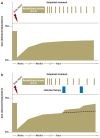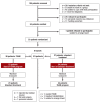Long-term Rehabilitation in Patients With Acquired Brain Injury
- PMID: 27743470
- PMCID: PMC5078863
- DOI: 10.3238/arztebl.2016.0634
Long-term Rehabilitation in Patients With Acquired Brain Injury
Abstract
Background: Patients with acquired brain injury who have been discharged from inpatient neurological rehabilitation often continue to suffer from limited independence, participation, and quality of life. Participation-focused outpatient treatment (in German: teilhabeorientierte ambulan.
Methods: In a randomized, controlled trial, 53 patients who had sustained an acquired brain injury approximately four years earlier were allotted to two different sequences of treatment (26 TEAM/control, 27 control/TEAM). The primary endpoint was the achievement of an individual participation goal one month after the start of treatment. The secondary endpoints included independence in everyday activities, health-related quality of life, participation, and need for nursing care. The intervention was four weeks long and was carried out on an outpatient basis (19.4 ± 1.3 hours per week). Patients in the control group were treated in a manner resembling usual current care. All endpoints were evaluated in a per-protocol (PP) analysis of data from 47 patients. For confirmation, an intention-to-treat (ITT) analysis was also carried out for the primary endpoint and for independence in everyday activities.
Results: According to the PP analysis, TEAM patients achieved their individual participation goals at 1 month more frequently than control patients receiving standard treatment (61% vs. 21%; p = 0.008) and improved more with respect to independence in everyday activities. The difference between TEAM and standard treatment was +7.3 points on the FIM (Functional Independence Measure) scale (95% confidence interval [2.8; 11.8]; p = 0.0024). The superiority of TEAM was confirmed by the ITT analysis (achievement of the participation goal, TEAM vs. standard treatment: 54% vs. 19%, p = 0.0103). Moreover, improvements were seen at 12 months in quality of life, participation, and the need for nursing care.
Conclusion: The TEAM rehabilitation program can help patients in the chronic phase of acquired brain injury achieve participation goals that are relevant to everyday life. An adjustment of the care structure in Germany to include such intensive goal-oriented rehabilitation programs would lead to a more effective mobilization of these patients' potential for long-term rehabilitation.
Figures






References
-
- Feigin VL, Barker-Collo S, Krishnamurthi R, Theadom A, Starkey N. Epidemiology of ischaemic stroke and traumatic brain injury. Best Pract Res Clin Anaesthesiol. 2010;24:485–494. - PubMed
-
- Bundesarbeitsgemeinschaft für Rehabilitation (BAR) e. V. Frankfurt: 1999. Empfehlungen zur Neurologischen Rehabilitation von Patienten mit schweren und schwersten Hirnschädigungen in den Phasen B und C.
Publication types
MeSH terms
LinkOut - more resources
Full Text Sources
Other Literature Sources
Miscellaneous

